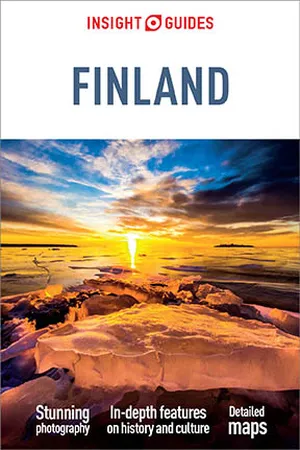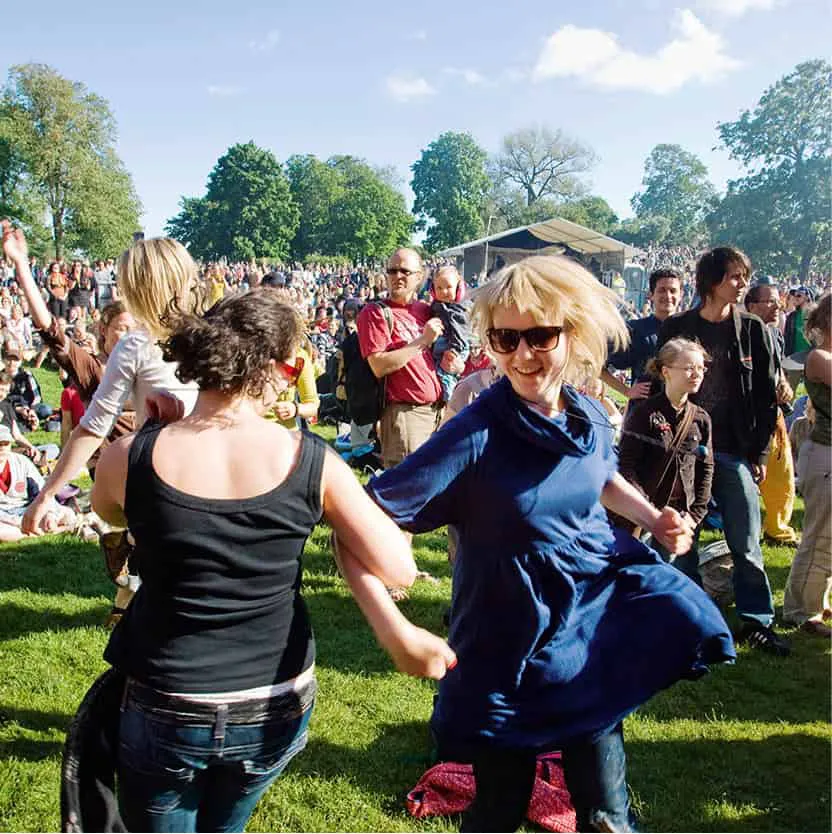Surrounding the city, the sea appears in Helsinki when you least expect it, its salty tongue lapping at the edges of metropolitan bridges and boulevards, pressing its way into residential areas, forming natural harbours and bays.
In summer, the sea glistens under a tireless sun, driving the light-starved locals wild with its rays and heat. Autumn arrives and, as darkness encroaches and the rains begin to fall, it begins its churn, spawning a world of wet and grey where the borders between sea and land are no longer distinct. Only during the long, cold winter does the sea finally rest, freezing into an endless expanse on which weekend promenaders can walk dogs or try out their cross-country skis.
Long referred to as the ‘Daughter of the Baltic’, it is to the sea that Helsinki owes its fortunes, its climate and perhaps even the massive, undulating nature of its architecture. It is also to the Baltic that the city owes much of its relatively short but turbulent history.
Festival, Esplanade Park.
Helsinki Tourism
Helsinki’s history
Helsinki was founded in 1550 by King Gustav Vasa of Sweden-Finland to compete with Tallinn, just across the Gulf of Finland, then a port controlled by the Hanseatic League. A first fledgling settlement was erected on the mouth of the Vantaa River at the innermost point of the Helsinki Bay – a little northeast of where Helsinki stands today. In order to populate the town of Helsingfors (‘Helsinge’, the local parish, plus ‘fors’, Swedish for ‘rapids’), Gustav Vasa simply ordered citizens from Porvoo, Ulvila and Rauma to move to the new town.
The new port proved, however, to be not only unpopular but a money-loser as well, once the shallow inner bay became shallower and impossible to navigate. It languished for nearly a century until a visiting governor general named Per Brahe recommended it be moved further south towards the open sea. On this new site, Kruununhaka, Helsinki finally began to grow, though it still wasn’t much more than an outpost for fishermen and farmers. Then the Russian Empire stirred against Sweden, and the town’s small fortunes began to go downhill. After battling against the Great Famine in 1696 and the Great Plague in 1710, in 1713 Helsinki was set on fire and reduced to ashes by its own defenders, outnumbered by 17,000 Russian besiegers in the Great Northern War (1710–1721).
Tram passing by an Art Nouveau building.
Helsinki Tourism
Helsinki prospers
Sweden’s decision in 1746 to build Suomenlinna Fortress off the shore of Helsinki (for more information, click here), to protect what remained of its Finnish territory saved the city. Construction of the fortress drew attention to the port and brought it its first taste of wealth. Merchants constructed a clutch of stone houses and, although streets were still unpaved, some semblance of European cultural life took root.
In 1808, the Russians wrested the fortress from Sweden, annexing Finland the following year and making Helsinki the capital of their new territory. Russian money, and the talents of German architect Carl Ludwig Engel, were poured into the creation of administrative halls and a cathedral. As the city began to enjoy steady prosperity from around 1850, workers’ homes were mostly replaced with stone ones. By 1900, Helsinki had grown from a small port with some 20,000 inhabitants into a bona fide capital city. The population soared to 100,000, a railway was built, and gasworks, electricity and water mains all laid down. At the same time, Helsinki became the seat of the nationalist movement. Native architects, such as Eliel Saarinen, then Alvar Aalto, emerged; after independence in 1917, the more Finnish Functionalism replaced Jugendstil (the German version of Art Nouveau) as Helsinki’s predominant architectural style.
Unfortunately, nothing could protect the city from the massive Russian air raids of 1944 – nor from fervent, and not always aesthetically pleasing, post-war reconstruction. But Helsinki’s position on the sea resurfaced to help it regain and then increase its stature, not only as a major port but eventually also as the important site for shipbuilding, international conferences and tourism it has become today.
Wikström’s massive figures adorning Helsinki Railway Station.
VisitFinland
The city today
Modern Helsinki is a tranquil but still growing city with some 630,000 inhabitants – many of whom are second-generation city dwellers. Gone are the marshes and wooden houses, but the fishermen who sell their catch straight from the docks are reminders that this capital’s urbanisation is relatively recent. Helsinki isn’t a frivolous city but the Finns have let their innate artistry flavour their capital. Statues stand on every other corner, and even the most functional of buildings are notable monuments to Finland’s architectural history. The city is not resting on its laurels either: Helsinki was recognised as the World Design Capital in 2012, with €16 million earmarked to enhance the city through design projects.
Consider the Railway Station 1 [map] (Rautatieasema). Finland’s most-visited building connects Helsinki with numerous commuter cities as well as the rest of the country. It also contains both a metro station stop and an underground shopping complex. The station is a strikingly stylish, round-edged structure in pinkish granite with green trim, a black roof and a 48-metre (160ft) green clock tower.
Designed by Eliel Saarinen in 1905 but not completed until 1919, it links two of Helsinki’s most prevalent styles: National Romanticism and Functionalism (for more information, click here). It also incorporates work by several other well-known Finns. Thanks to Emil Wikström, pairs of solemn-faced, muscular giants hold translucent lanterns on either side of the station’s impressive front doors. A large painting by Eero Järnefelt looks over the Eliel Restaurant inside.
The SpåraKOFF Bar Tram (www.virginoil.fi/in-english/sparakoff; May–early Sept Mon–Sat, trams leave from the Mikonkatu tram stop at 2pm, 3pm, 5pm, 6pm and 7pm and 8pm, and in July–mid-Aug also 1pm on Fri–Sat) follows a scenic route around the inner city and has two beer taps on board to help you relax. Stops include Kauppatori, Student House and the Opera House.
The railway station has a more metropolitan focus compared to the somewhat rustic harbour. It is a good reference point for a city tour; most places of interest to visitors are within walking distance of here.
Exploring the city
The first thing to do before beginning a tour of Helsinki, however, is to find your directional bearings. These are not immediately obvious because much of central Helsinki lies on a peninsula, jutting southward into the Baltic. Being by the sea, therefore, doesn’t automatically mean you are in the south of the city. In fact, the peninsula has only a brief southern shore but extended longitudinal coasts on both its eastern and wes...




